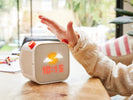
Raising Screen-Free Kids: How Yoto Players Make It Easier (and More Magical)
, by Jack Jones, 4 min reading time

, by Jack Jones, 4 min reading time
In today’s digital world, it can feel nearly impossible to keep children screen-free. Between tablets, smartphones, smart TVs, and endless apps, screens are everywhere—and often marketed as educational tools. But growing research suggests that too much screen time can negatively affect children’s attention, sleep, emotional regulation, and even brain development. That’s why more families are making the intentional choice to go screen-free—and why tools like the Yoto Player are becoming essential parts of that journey.
The good news? Going screen-free doesn’t mean going fun-free. With the right tools, kids can thrive without glowing rectangles. Yoto helps make that possible—by blending storytelling, music, learning, and imagination in a totally screenless way.
According to the American Academy of Pediatrics, children under 5 should have limited screen time, and older kids need boundaries around their tech use. Why? Because too much screen exposure has been linked to:
When screens dominate a child’s environment, they tend to consume content passively. In contrast, screen-free activities—like building, storytelling, or listening to audio—encourage active participation. Children imagine, move, question, and create.
But going screen-free isn’t just about saying “no” to screens. It’s about saying “yes” to alternatives that nourish a child’s developing mind. That’s where Yoto steps in.
Yoto Players are screen-free audio devices designed specifically for kids. They play stories, music, educational content, and even mindfulness exercises through physical cards that children insert themselves. There’s no microphone, camera, or advertising—just a simple interface with kid-friendly buttons and a pixel display.
The Yoto ecosystem includes:
With its tactile cards and simple controls, the Yoto Player empowers even very young children to select their own content. This sense of autonomy encourages independent play, giving kids the freedom to entertain themselves without relying on an adult—or a screen.
Because there are no visuals, children must paint pictures in their minds as they listen. That kind of mental imagery strengthens creativity, language development, and memory. Whether it’s listening to Winnie the Pooh or Roald Dahl, kids are actively engaged, not just watching passively.
Yoto is a favorite for bedtime and quiet time. With sleep sounds, nightlight functionality, and relaxing stories, it helps create screen-free evening routines that soothe rather than stimulate. The result? Better sleep, healthier habits, and calmer kids.
From math songs and phonics to world history and science facts, Yoto Cards cover a huge range of educational content. But because it’s all audio-based, kids absorb information without screen fatigue. Many parents say their children retain more from listening than from watching.
The Make Your Own Cards feature allows parents, grandparents, or faraway family members to record custom messages, lullabies, or stories. This adds a personal layer of connection that a screen simply can’t offer.
Imagine a five-year-old waking up and choosing a cheerful episode of Yoto Daily to start their morning. Later, they grab the Storytime Adventures card and act out scenes from a fairy tale on their playmat. In the car, they pop in a Science Facts card and ask questions the whole ride. And at bedtime, they listen to calming music and fall asleep without ever seeing a screen.
That’s not a fantasy—it’s a normal day with Yoto. No overstimulation. No screen meltdowns. Just a rhythm of play and rest built on imagination, learning, and calm.
Raising screen-free kids is a choice that requires intention—but it doesn’t have to feel like a struggle. Yoto makes it not only easier, but joyful. It puts the power of storytelling and learning back in kids’ hands, fostering independence, creativity, and curiosity without ever lighting up a screen.
In a world full of noise, Yoto offers something better: a space for kids to listen, imagine, and grow. It’s more than a gadget—it’s a screen-free companion for childhood.